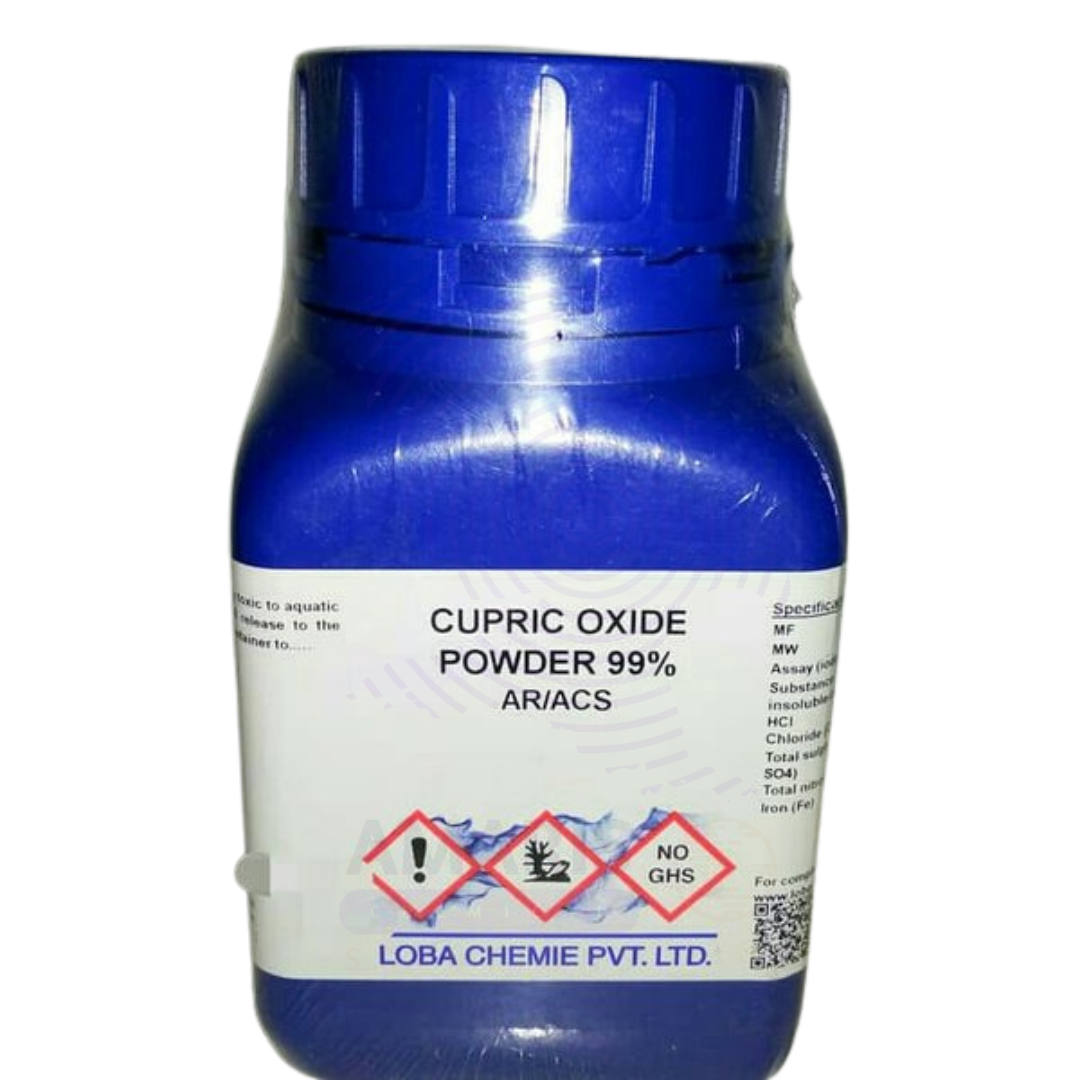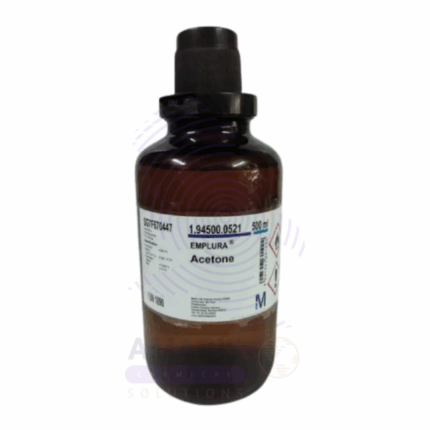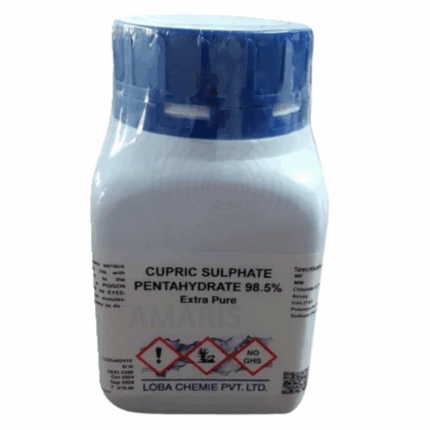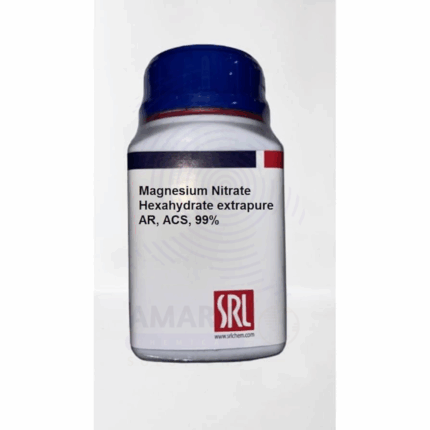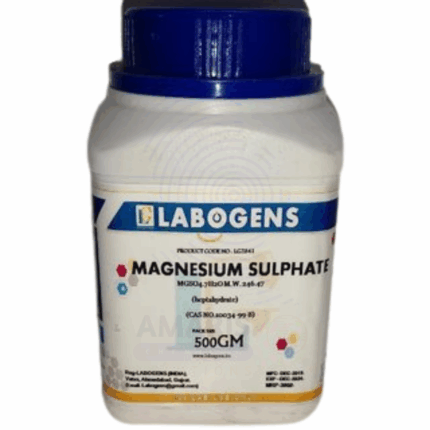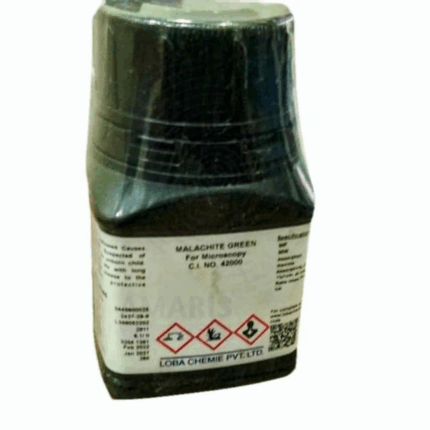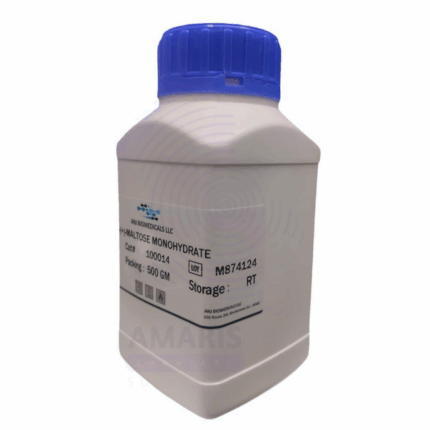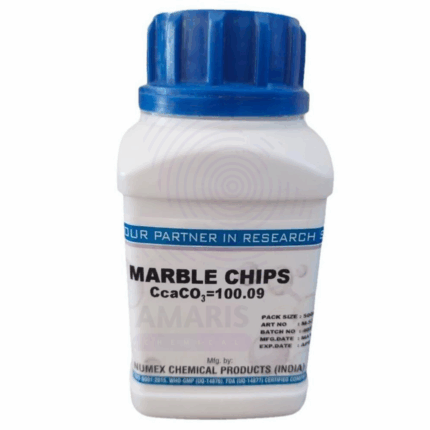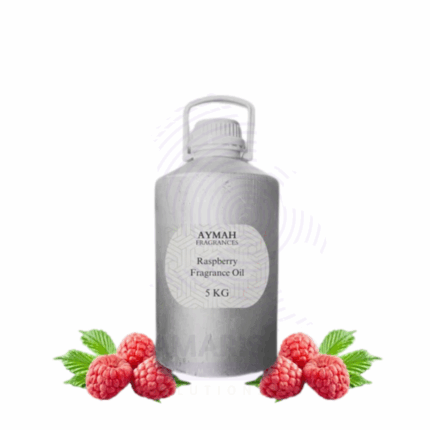
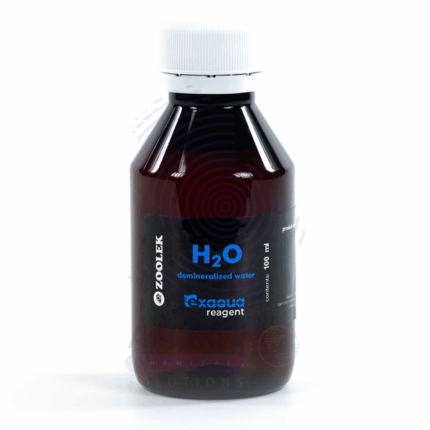
Cupric Oxide Extra Pure
$ 22.30 Original price was: $ 22.30.$ 22.10Current price is: $ 22.10.
Cupric Oxide Extra Pure is a black, fine powder extensively used in laboratory settings as a stable, high-purity source of copper in oxidation state +2. It is commonly applied in organic synthesis, inorganic reactions, and thermal decomposition studies, as well as in qualitative and quantitative analysis of copper. Its thermal stability also makes it suitable for ceramic glazing and as a precursor in catalyst preparation. This extra pure grade ensures low impurity levels, essential for accurate experimental results and reproducible data in both educational and research laboratories. It should be stored in a tightly sealed container away from moisture and strong acids.
Cupric Oxide Extra Pure
Primary Uses
- Precursor in Inorganic Synthesis
- Used to prepare other copper salts and complexes via acid-base or redox reactions.
- Reacts with mineral acids (like HCl or H₂SO₄) to yield CuCl₂, CuSO₄, etc.
- Oxidizing Agent
- Functions as a mild oxidizer in reactions involving organic compounds, particularly in combustion or thermal degradation tests.
- Black Pigment in Ceramics & Glass
- Added to glazes in lab-scale ceramic work to produce green to black coloration depending on firing conditions.
- High-Temperature Experiments
- Utilized in thermal decomposition and catalytic oxidation studies due to its thermal stability.
Secondary Uses
- Analytical Chemistry
- Acts as a reference oxide in oxide-reduction titrations.
- Occasionally used in oxygen determination experiments via reduction to copper metal.
- Material Science & Surface Coatings
- Investigated for semiconducting, photocatalytic, and antifouling properties in lab-scale studies.
- Demonstration Experiments
- Demonstrates metal oxide behavior, reduction to elemental copper, and reaction with acids in educational labs.
| PACK SIZE |
100 grams Plastic Tin |
|---|
1. Basic Identification Attributes
- Chemical Name: Cupric Oxide
- Common Name: Copper(II) Oxide
- CAS Number: 1317-38-0
- Chemical Formula: CuO
- Molar Mass: 79.55 g/mol
- Grade: Extra Pure (Laboratory/Reagent grade)
2. Physical & Chemical Properties
- Appearance: Black fine powder
- Odor: Odorless
- Solubility:
- Insoluble in water
- Soluble in acids (e.g., HCl, HNO₃)
- Melting Point: ~1,200°C
- Boiling Point: Decomposes
- Density: ~6.3 g/cm³
- Stability: Stable under recommended storage conditions
3. Safety & Hazard Attributes
- GHS Classification:
- ⚠️ Warning
- H302: Harmful if swallowed
- H319: Causes serious eye irritation
- H332: Harmful if inhaled
- H410: Very toxic to aquatic life with long-lasting effects
- NFPA Ratings:
- Health: 2
- Flammability: 0
- Reactivity: 0
- First Aid Measures:
- Inhalation: Remove to fresh air; seek medical help if breathing difficulty persists
- Skin Contact: Wash with water and soap
- Eye Contact: Rinse cautiously with water for several minutes
- Ingestion: Rinse mouth and seek medical attention immediately
4. Storage & Handling Attributes
- Storage Conditions:
- Store in tightly sealed containers
- Keep in cool, dry, and well-ventilated place
- Protect from incompatible substances like strong acids and reducing agents
- Handling Advice:
- Avoid dust generation and inhalation
- Use personal protective equipment (PPE): gloves, goggles, lab coat
- Work in fume hood when dust is present
5. Regulatory & Compliance Attributes
- EINECS Number: 215-269-1
- UN Number: Not regulated for transport
- REACH Status: Registered
6. Applications in Laboratory
- Primary Use:
- Precursor in the synthesis of copper salts and compounds
- Other Uses:
- Catalyst in organic reactions
- Oxidizing agent
- Pigment in ceramics and glass
- Component in thermite reactions for metal reduction
- Used in chemical analysis and educational labs
SAFETY PRECAUTIONS
- PPE Required:
- Lab coat
- Nitrile or neoprene gloves
- Safety goggles or face shield
- Use of fume hood is recommended during weighing or heating
- Handling:
- Avoid inhaling dust; handle with care to prevent dispersion
- Do not ingest or allow contact with skin or eyes
- Use dedicated spatulas and avoid contamination
- Storage:
- Store in tightly sealed containers
- Keep in a dry, cool, and ventilated area
- Avoid storing near strong acids or reducing agents
FIRST AID MEASURES
- Inhalation:
- Move person to fresh air
- Seek medical advice if symptoms persist
- Skin Contact:
- Wash thoroughly with soap and water
- Remove contaminated clothing
- Eye Contact:
- Rinse cautiously with water for at least 15 minutes
- Seek medical attention immediately
- Ingestion:
- Rinse mouth with water
- Do not induce vomiting
- Seek immediate medical help
FIREFIGHTING MEASURES
- Flammability: Non-combustible
- Hazards: Emits toxic fumes of copper oxides if heated excessively
- Extinguishing Media:
- Use suitable extinguishing agents for surrounding fire (dry powder, foam, CO₂)
- Avoid water if material is hot to prevent steam pressure build-up
- Firefighter Protection:
- Wear protective suit and self-contained breathing apparatus (SCBA)


 Preservatives(food)
Preservatives(food) Flavor Enhancers
Flavor Enhancers Acidulants
Acidulants Sweeteners
Sweeteners Antioxidants
Antioxidants Colorants(food)
Colorants(food) Nutraceutical Ingredients (food)
Nutraceutical Ingredients (food) Nutrient Supplements
Nutrient Supplements Emulsifiers
Emulsifiers
 Collectors
Collectors Dust Suppressants
Dust Suppressants Explosives and Blasting Agents
Explosives and Blasting Agents Flocculants and Coagulants
Flocculants and Coagulants Frothers
Frothers Leaching Agents
Leaching Agents pH Modifiers
pH Modifiers Precious Metal Extraction Agents
Precious Metal Extraction Agents
 Antioxidants(plastic)
Antioxidants(plastic) Colorants (Pigments, Dyes)
Colorants (Pigments, Dyes) Fillers and Reinforcements
Fillers and Reinforcements Flame Retardants
Flame Retardants Monomers
Monomers Plasticizers
Plasticizers Polymerization Initiators
Polymerization Initiators Stabilizers (UV, Heat)
Stabilizers (UV, Heat)
 Antifoaming Agents
Antifoaming Agents Chelating Agents
Chelating Agents Coagulants and Flocculants
Coagulants and Flocculants Corrosion Inhibitors
Corrosion Inhibitors Disinfectants and Biocides
Disinfectants and Biocides Oxidizing Agents
Oxidizing Agents pH Adjusters
pH Adjusters Scale Inhibitors( water)
Scale Inhibitors( water)
 Antioxidants(cosmetic)
Antioxidants(cosmetic) Emollients
Emollients Fragrances and Essential Oils
Fragrances and Essential Oils Humectants
Humectants Preservatives
Preservatives Surfactants(cosmetic)
Surfactants(cosmetic) Thickeners
Thickeners UV Filters
UV Filters
 Fertilizers
Fertilizers Soil Conditioners
Soil Conditioners Plant Growth Regulators
Plant Growth Regulators Animal Feed Additives
Animal Feed Additives Biostimulants
Biostimulants Pesticides (Herbicides, Insecticides, Fungicides)
Pesticides (Herbicides, Insecticides, Fungicides)
 Active Pharmaceutical Ingredients (APIs)
Active Pharmaceutical Ingredients (APIs) Excipients
Excipients Solvents(pharmaceutical)
Solvents(pharmaceutical) Antibiotics
Antibiotics Antiseptics and Disinfectants
Antiseptics and Disinfectants Vaccine Adjuvants
Vaccine Adjuvants Nutraceutical Ingredients (pharmaceutical)
Nutraceutical Ingredients (pharmaceutical) Analgesics & Antipyretics
Analgesics & Antipyretics
 Analytical Reagents
Analytical Reagents Solvents(lab)
Solvents(lab) Chromatography Chemicals
Chromatography Chemicals Spectroscopy Reagents
Spectroscopy Reagents microbiology-and-cell-culture-reagents
microbiology-and-cell-culture-reagents Molecular Biology Reagents
Molecular Biology Reagents Biochemical Reagents
Biochemical Reagents Inorganic and Organic Standards
Inorganic and Organic Standards Laboratory Safety Chemicals
Laboratory Safety Chemicals Specialty Laboratory Chemicals(Special Laboratory Equipment)
Specialty Laboratory Chemicals(Special Laboratory Equipment)
 Demulsifiers
Demulsifiers Hydraulic Fracturing Fluids
Hydraulic Fracturing Fluids Scale Inhibitors(oil)
Scale Inhibitors(oil) Surfactants(oil)
Surfactants(oil) Drilling Fluids
Drilling Fluids
 Dyes and Pigments
Dyes and Pigments Bleaching Agents
Bleaching Agents Softening Agents
Softening Agents Finishing Agents
Finishing Agents Antistatic Agents
Antistatic Agents
 Admixtures
Admixtures Waterproofing Agents
Waterproofing Agents Sealants and Adhesives
Sealants and Adhesives Curing Compounds
Curing Compounds Concrete Repair Chemicals
Concrete Repair Chemicals Anti-Corrosion Coatings
Anti-Corrosion Coatings
 Surfactants(cleaning)
Surfactants(cleaning) Builders
Builders Enzymes
Enzymes Solvents (Cleaning)
Solvents (Cleaning) Fragrances
Fragrances
 Electronic Chemicals
Electronic Chemicals Catalysts
Catalysts Lubricants
Lubricants Photographic Chemicals
Photographic Chemicals Refrigerants
Refrigerants Automotive chemicals
Automotive chemicals Pyrotechnic Chemicals
Pyrotechnic Chemicals
 Biodegradable Surfactants
Biodegradable Surfactants Bio-based Solvents
Bio-based Solvents Renewable Polymers
Renewable Polymers Carbon Capture Chemicals
Carbon Capture Chemicals Wastewater Treatment Chemicals
Wastewater Treatment Chemicals
 Pigments
Pigments Solvents(paint)
Solvents(paint) Specialty Coatings
Specialty Coatings Binders/Resins
Binders/Resins Additives
Additives Driers
Driers Anti-Corrosion Agents
Anti-Corrosion Agents Functional Coatings
Functional Coatings Application-Specific Coatings
Application-Specific Coatings
 Fresh Herbs
Fresh Herbs Ground Spices
Ground Spices Whole Spices
Whole Spices Spice Blends
Spice Blends Dried Herbs
Dried Herbs
 Leavening Agents
Leavening Agents Dough Conditioners
Dough Conditioners Flour Treatments
Flour Treatments Fat Replacers
Fat Replacers Decoratives
Decoratives Preservatives(baking)
Preservatives(baking)
 Plasticizers & Softeners
Plasticizers & Softeners Reinforcing Agents
Reinforcing Agents Adhesion Promoters
Adhesion Promoters Vulcanizing Agents
Vulcanizing Agents Antidegradants
Antidegradants Blowing Agents
Blowing Agents Fillers & Extenders
Fillers & Extenders Accelerators & Retarders
Accelerators & Retarders